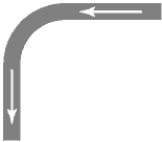The diagram shown represents a portion of a wire in a circuit. A current is flowing in the wire in the direction shown. Under the convention that it is positive charge that flows the electric field points in the direction of the current. How can the electric field change direction where the wire bends? 
A) There is an excess of negative charge in the center of the wire.
B) There is an excess of positive charge at the bottom end of the wire.
C) There is an excess of negative charge at the right end of the upper portion of the wire.
D) There is an accumulation of positive charge on the surface, particularly at the bend, such that the sum of electric fields gives the new electric field.
E) There is an accumulation of electrical potential as the current traverses the wire: The higher potential in the lower half is the source of the field.
Correct Answer:
Verified
Q58: The algebraic sum of the changes of
Q59: What is the equivalent resistance between points
Q60: What is the equivalent resistance between points
Q61: The circuit below contains 5 identical light
Q62: The circuit below contains three 100-W light
Q64: The circuit below contains 3 100-W light
Q65: The circuit below contains 4 100-W light
Q66: Which of the identical light bulb(s) is(are)
Q67: A parallel circuit consists of a 100
Q68: The capacitors are completely discharged in the
Unlock this Answer For Free Now!
View this answer and more for free by performing one of the following actions

Scan the QR code to install the App and get 2 free unlocks

Unlock quizzes for free by uploading documents